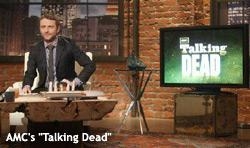
Lost
in the big fuss earlier this week about the titanic audience that tuned in for the Season Four premiere of AMC’s “The Walking Dead” -- which drew 16.1 million viewers, 10.4 of them
in the prized 18-49 demographic -- was the performance of “Talking Dead,” the live talk show that follows every new episode of the zombie thriller. A not insignificant total of 5.1 million
viewers -- 2.6 of them adults 18-49 -- watched host Chris Hardwick talk about the hour of horror that preceded his program with guests Scott M. Gimple, the new show-runner of “Dead,” and
Nathan Fillion, the star of “Castle” and a self-proclaimed “Dead” super-fan.
The success of “Talking Dead” continues to fascinate me, simply because it is just
about the most basic concept imaginable for a television program -- a live talk show that follows new episodes of a powerful television series that leaves its viewers worked up and anxious to talk
about what they just watched, or at least listen to others express their thoughts about it. In form, “Talking Dead” is essentially just a step or two up from local public access talk
programming -- albeit with a budget much bigger than access, and yet so much smaller than most of the rest of the programs on prime-time television, not just on broadcast but on basic cable as well.
Zombie-crazed viewers can call in or communicate in other ways and submit questions for Hardwick and his guests about the episode they have just seen.
advertisement
advertisement
Considering the money put into each
episode of the show, an audience of 5.1 million makes for a fantastic return on a very modest investment. There are an awful lot of scripted and unscripted programs on television that spend a lot more
money and attract far fewer people in the process.
“Talking Dead” began in 2011 as a half-hour program but expanded to an hour the following year because of its growing popularity.
It was the inspiration for “Talking Bad,” the live talk show also hosted by Hardwick that followed each episode of “Breaking Bad” during its final season. One might presume
that a show titled “Talking Mad” will arrive on AMC next summer, for obvious reasons, but one should never take anything for granted where AMC is concerned. (Hardwick, by the way, will
have his own late-night pop-culture competition series titled “@midnight” Monday-Thursday at 12 a.m. on Comedy Central beginning October 21.)
It’s surprising that more
entertainment related and show-supporting talk shows haven’t popped up on other networks, given the colorful series on so many of them that might drive viewers to such an effort, including
History’s “Vikings,” A&E’s “Duck Dynasty” and “Bates Motel” and just about every drama on FX. Indeed, FX has taken baby steps into this area with a
live Internet talk show titled “After Anarchy” that follows each new episode of “Sons of Anarchy,” but it is only for the indefatigable, because “Sons” this season
has been offering 90-minute episodes that keep East Coast viewers up until 11:30 every Tuesday night, and for many of them watching a live Internet follow-up program is just too much to ask, even if
it is a great idea. (Somehow, the idea of recording the live show and watching it at another time seems less satisfying than it should. “Walking Dead” is telecast at 9 p.m. ET, leaving
plenty of time at 10 p.m. for “Talking Dead.”)
By the way, MTV earlier this week announced that when its genre hit “Teen
Wolf” returns in January each new episode will be followed by a talk show titled “Wolf Watch.” No word on whether it will be a live program. It probably ought to be.
Advertisers are getting into the act, as well. Last Sunday’s “Talking Dead” featured a segment during a commercial break that was presented by Subway. It highlighted interesting
behind the scenes information from the making of the episode of “Walking Dead” that preceded it. “Please enjoy some fresh facts from tonight’s episode,” Hardwick told the
audience before a graphic filled the screen. It read: “Subway’s Fresh Buzz.” A traditional spot for Subway followed the behind the scene's mini-feature.
I’m always so
impressed when advertisers figure out new ways to integrate their products into shows without compromising the shows themselves. This is a much smarter approach to connecting with an audience than
simply producing random commercials and dropping them into shows, where they are crunched up against other random commercials in such a way that the whole lot of them is just asking to be scanned
through.
Of course, all of these shows owe a debt of sorts to Bravo’s “Watch What Happens Live,” the infectiously entertaining Sunday-Thursday live half-hour late-night talk
show in which the network’s high-energy programming guru Andy Cohen chats with celebrity guests, very often about Bravo programming. “WWHL” encourages instant interaction with its
viewers via the usual means: Calling, texting, tweeting, Facebook posting, e-mailing, etc. The big difference between “WWHL” and “Talking Dead,” other than frequency and
duration, is that while the conversation on “WWHL” can be wide-ranging (and sometimes very personal), the talk on “Talking Dead” is all geek, all the time, and almost
exclusively devoted to the zombie show that is the reason for its existence.